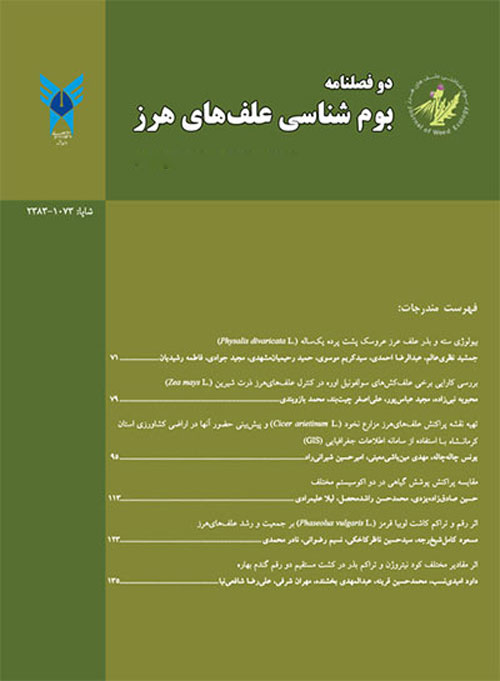Weed Map Distribution of Chickpea (Cicer arietinum L.) Fields and Prediction of Their Presence in Agricultural Fields of Kermanshah Province with Using Geographic Information System (GIS)
Author(s):
Abstract:
Recognizing the composition of weed community in chickpea field is the most fundamental issues in weed crop management. Based on chickpea acreage and overall field areas in Kermanshah province during 2009-2010, fifty-two farms were selected as indicators of chickpea fields in the province. The weeds in sampling points were counted based on overall plants and each species and their population indices were calculated. In each field, at sampling points, the longitudes, latitudes and altitudes were determined via GPS device. By using this information, the distribution maps of different weed species of chickpea fields in Kermanshah produced via GIS software. The results showed that there were sixty-one weed species in chickpea fields of Kermanshah province. The ranking of predominant broadleaf weeds of chickpea fields in Kermanshah were included of succory (Cichorium intybus), field bind weed (Convolvulus arvensis), bed straw (Galium tricornatum), wild safflower (Carthamus oxycantha) and cowcockie (Vaccaria pyramidata), of Kermanshah province, respectively. Dominant grasses of chickpea fields in Kermanshah province were included: wild barley (Hordeum spontaeum), spring wild oat (Avena fatua) and Bermuda grass (Cynodon dactylon), respectively. Based on Shannon-Wiener species diversity index, different cities were classified into three clusters. Being in low value for Simpson abundance index of some cities were similar to being low Shannon-Wiener index and were indicated the presence of non-uniform community with the presence of dominant species in chickpea fields of these cities. There were significant differences among of chickpea field's weeds of different cities in regard to species diversity, only the difference between Kermanshah city and Dalaho and Ravansar cities was significant. The predictive maps of different species based on their soil and climatic requirements showed that shifting of these species toward area with similar ecological conditions are able to infest the area and should prevent weed infestation of new area.
Keywords:
Language:
Persian
Published:
Journal of Weed Ecology, Volume:2 Issue: 2, 2015
Pages:
95 to 112
magiran.com/p1404184
دانلود و مطالعه متن این مقاله با یکی از روشهای زیر امکان پذیر است:
اشتراک شخصی
با عضویت و پرداخت آنلاین حق اشتراک یکساله به مبلغ 1,390,000ريال میتوانید 70 عنوان مطلب دانلود کنید!
اشتراک سازمانی
به کتابخانه دانشگاه یا محل کار خود پیشنهاد کنید تا اشتراک سازمانی این پایگاه را برای دسترسی نامحدود همه کاربران به متن مطالب تهیه نمایند!
توجه!
- حق عضویت دریافتی صرف حمایت از نشریات عضو و نگهداری، تکمیل و توسعه مگیران میشود.
- پرداخت حق اشتراک و دانلود مقالات اجازه بازنشر آن در سایر رسانههای چاپی و دیجیتال را به کاربر نمیدهد.
In order to view content subscription is required
Personal subscription
Subscribe magiran.com for 70 € euros via PayPal and download 70 articles during a year.
Organization subscription
Please contact us to subscribe your university or library for unlimited access!


